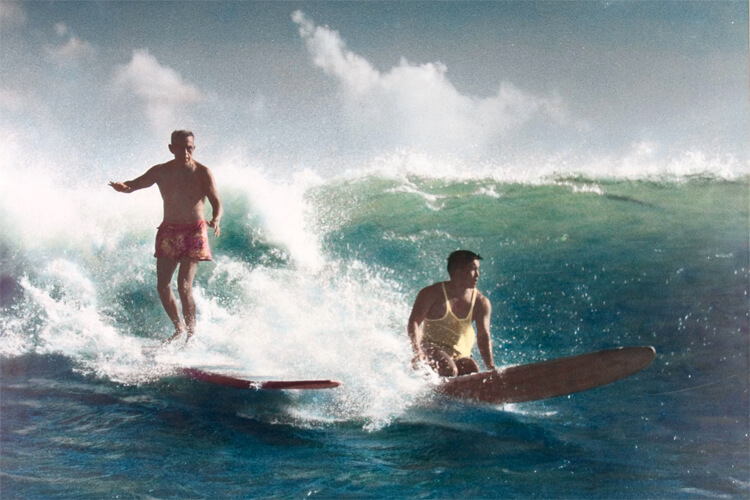The call of the surf is a constant call that throbs deep in the bloodstream of all island races.
From prehistoric times, man has answered this call in a variety of ways, in canoes and coracles, in dinghies, in scows and whaleboats, but when at last the Pacific came to be explored, it was in the blue-green bays of the Islands of Hawaii that surfing - as we know it - was first observed.
There, the native Polynesians spun their wayward boards with bewildering skill as they hurtled down the faces of the breaking waves.
There, surfing was the sport of kings, and there, over a century later, the first white man learned to surf, so that to this day, Hawaii has retained its eminence as the surfing capital of the world.
It was in Hawaii that I first tried the surf in the fall of 1956.
On a subsequent trip to the Islands during 1960-1962, I was fortunate enough to spend many days on Waikiki Beach.
This book ["Surfing in Hawaii" (1962)] is the story of how I learned to surf, covering the pitfalls and difficulties, such as I found them, in the hope that my modest discoveries may ease the path of other beginners in this the greatest sport of all.
And at the same time, I may recapture for older surfers the flavor of some of their triumphs and anxieties as they took to the waves in the dream-like surroundings of America's newest and most romantic state.
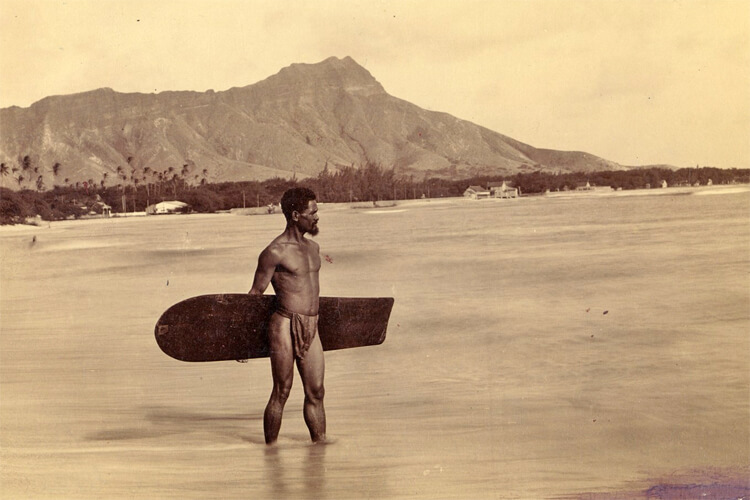
Surfing in Hawaii
Surfing is a very old sport, so old that its actual beginning cannot be traced.
In ancient Polynesia, there was no written language since both history and legend were handed down by word of mouth from parents to their children.
This exchange was usually in the form of chants, which were called meles in Hawaii.
There is ample evidence, from the many references in these chants, that the art of surf-riding was one of the most widespread of the Polynesian sports, practiced in one form or another throughout the Pacific region, from New Zealand to Hawaii, and from Easter Island to New Guinea.
When these places were eventually discovered by the Western world, it was in Hawaii that the sport was found to have reached its greatest development.
Anthropologists tell us that the Hawaiians crossed the Pacific in their outrigger canoes coming from Tahiti and Bora Bora, where they had previously lived.
Their language, customs, and arts all confirm this.
The types of surfing practiced in Tahiti and Hawaii, which are themselves similar, were far more skilled than those found on most of the other Pacific islands, where surfing on boards was usually practiced by children, and the sport was not well developed.
The probability that the Hawaiians left Tahiti 1,000 years ago and took their surfing habits with them would appear to confirm the early origins of surfing suggested by the chants.
On most of the Islands of Oceania, the boards used for surfing were small, less than five feet long, and modern practice indicates that these would not support a man other than in the prone position.
They were merely a gradation above what we call body surfing boards today.
It is significant that boards greater than five feet in length were found only in New Zealand, Tahiti, and Hawaii, and it is in Hawaiian chants alone that we find frequent reference to the positions of sitting, kneeling, and standing on the boards, as the surfers rode down the surfaces of the advancing waves.
Sports and dancing were a high priority in the lives of Hawaiians before the days of the white man.
The local Polynesians were pleasure-loving people who were tall, handsome, and athletic.
They have been described as the Greeks of the Pacific.
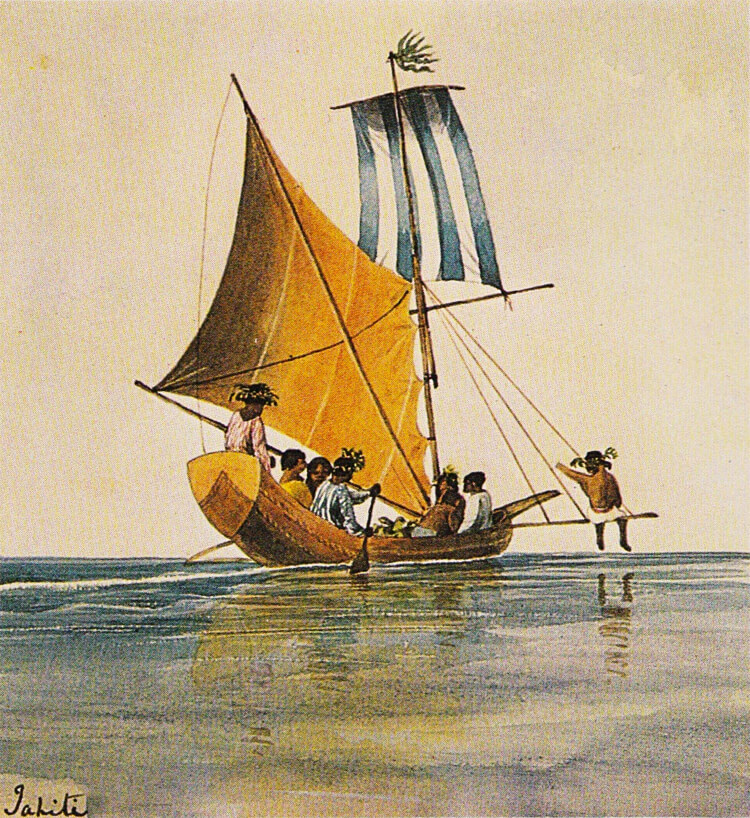
The Sport of Kings
Men, women and children, chiefs, and commoners alike spent much of their time in the water.
From examining the chants, there is no doubt that surfing was woven into every aspect of Hawaiian life.
Before the tabus were broken by the early missionaries and by Queen Kaahumanu, the chiefs or alii (ah-lee-e) had their own private beaches, which were forbidden, on pain of death, to lesser mortals, a widely used and uncommonly effective form of discouragement in primitive societies.
Surfing was literally the sport of kings, and they, in their turn, were often the best surfers, for, besides its religious implications, proficiency in the sport was a definite status symbol at all levels of Hawaiian life.
Nearly every Hawaiian, rich or poor, young or old, owned a surfboard, which was often used for travel as well as for pleasure.
Surf meets and water festivals were common, and there was widespread wagering on their outcome, for the Hawaiians alone among the people of Polynesia were great gamblers.
During a surfing match, in a rash moment, a man would sometimes bet his entire worldly possessions and, if he lost, in the best traditions of the Mississippi riverboats, he might bet his "body or his bones and thus chance losing his life or his liberty."
This was a wholly appropriate gesture for a vigorous sport like surfing, which left little room for the weak or faint-hearted.
Surfing beaches also provided a meeting place for the different sexes.
The Hawaiians were ever renowned for their lack of inhibitions, and sexual freedom was taken for granted.
In the early days, relations between the sexes had no serious consequences, and it was not until the white man brought his dreaded diseases to the Islands that difficulties arose.
Children were never a problem - all Hawaiians loved children extravagantly, and there was no such word as "orphan" in the Hawaiian language.
It was not conceivable that a Hawaiian child should be without a home.
So that, much in the same way that the hula and its accompanying music stirred the senses to a pitch that demanded fulfillment, it was naturally assumed that a man and woman who found themselves riding in on the same wave would terminate the passionate excitement of the ride in the way they found most fitting.
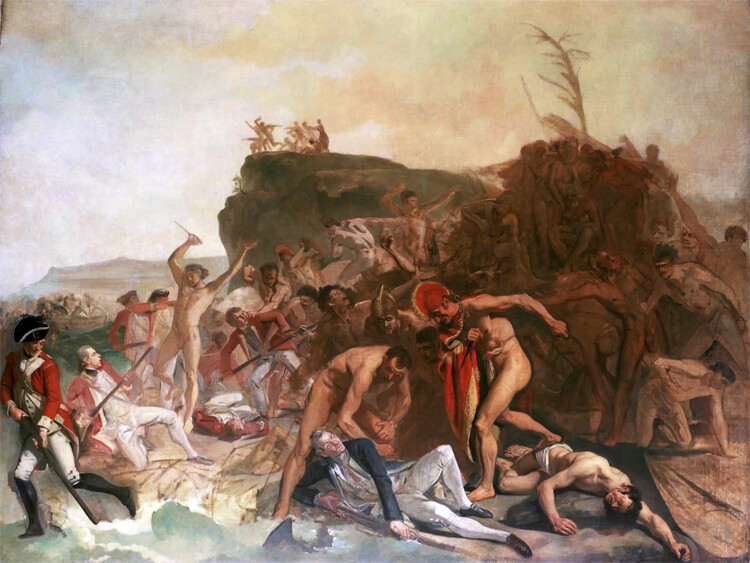
Captain James Cook's Arrival in Hawaii
For the first recorded account of surfing, we must turn to the journal of the first white man to visit these shores, a man whom many feel was also the greatest to have ever set foot on the Islands.
Captain Cook eventually left his bones in Kealakekua Bay on the Island of Hawaii, and the journals were taken over by Captain King, to whom the first description of surfing is credited.
After praising the dignity and relaxed happiness of the natives and their obvious mastery of swimming, canoeing, and other water sports, he notes the ship's entry to Kealakekua Bay.
In his best logbook English, he sets down the first recorded observations of surf-board riding.
Many other early historians refer to widespread interest in surfing, canoe-riding, and swimming during the period from Cook's discovery of the Islands until 1820, the date of the landing of the first missionary boat from Boston, with its cargo of Calvinists, bent on seeing that these happy savages should be converted to their own ascetic way of life.
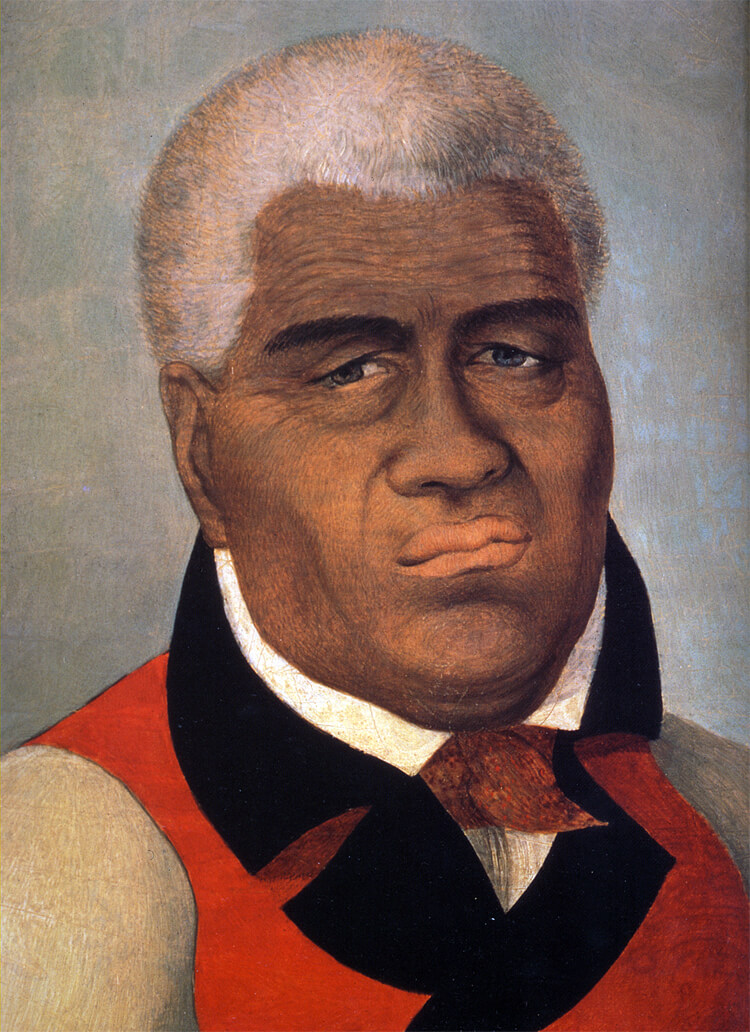
Kamehameha the Great (Surfer)
Kamehameha the Great, the most famous of the Hawaiian kings, was fortunate enough to reign after Cook's voyage and to die before the arrival of the missionaries.
During his time, he succeeded in uniting all the islands under one throne.
He was an athletic man who was just as renowned a surfer as he was a warrior.
When only a few weeks old, he was taught to swim in a mountain stream, and, in the tradition of the times, he was an expert in the water before he could walk.
At an early age, he was taught the various sports of spear throwing, wrestling, and surfing, the mastery of which developed the noble strength and physique which distinguished the alii from the common people in a land where an armed truce between the factions was the best that could be expected, and where the weak rarely lived out their allotted span.
John Ii, the Hawaiian historian, notes that the Holualoa lands of Kona on the island of Hawaii were specifically occupied by the ancient chiefs because the surfing there was good.
"There, Kamehameha (Kah-may-hah-may-hah) learned to surf and to glide with a canoe over the waves... Because he was well trained, Kamehameha excelled in these arts and in sailing canoes."
Later, as a young prince, Kamehameha went to Kau to join the court of his uncle, King Kalaniopuu. A boy was sent to Kau to prepare for Kamehameha's arrival.
"He located the place where he had been told to land and took the canoe ashore there, where a house was ready for him and his companions."
"That day, he raised his banner near the place for surfing, a pastime much enjoyed at that time."
"He knew that his beloved chief, Kamehameha, was very fond of surfing and that this would probably be a good way to have the chief recognize him immediately."
He was right.
Kamehameha saw the banner on his arrival at the surfing place and went at once to the boy.
After a few pleasantries had been exchanged, Kamehameha immediately went surfing and apparently continued to do this daily during his stay in Kau.
John Ii further notes that his mother had three names, one of which, Pahulemu, literally means "shove from the rear" and was "derived from a lack of skill in surfing which required the aid of the skilled."
"The learner would lie down on the board to ride in on the surf, while the skilled one held onto the back end (lemu) of the board when the surf rose."
"When the surf drew near, the instructor gave the board a shove (pahu), and the surfer rode nicely towards the shore. This was the meaning of that name, O companions."
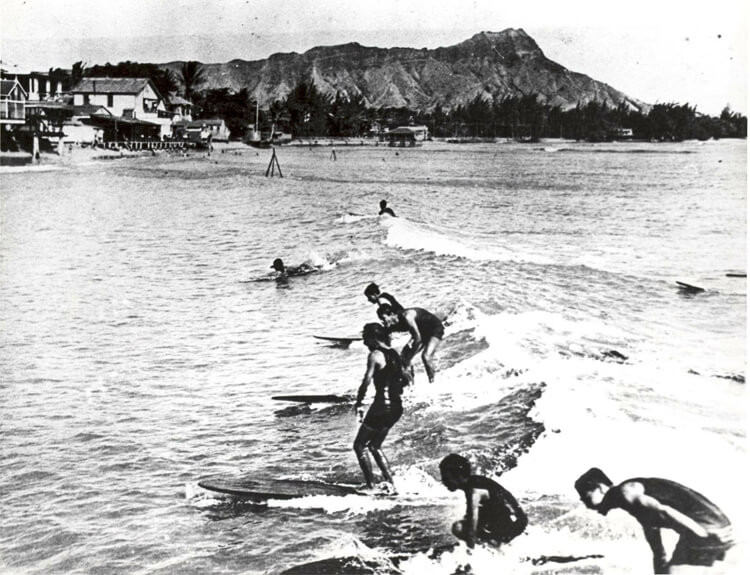
Waikiki: The Epicenter of Surfing
This same method of teaching beginners is still used today in the shallow waters of Waikiki and similar surfing beaches.
Waikiki had become the center of the surfing activity on Oahu ever since Honolulu Harbor, which had been the main haunt of surfers before the time of the whaling boats, was inevitably transformed into a busy commercial port.
The advantages of Waikiki lay in the great variety of size and form of the waves, which accommodated every possible type of surfer.
In the early years of the century, there are frequent references to Waikiki as a favored place for surfing - "on the day of Muku, the last day of the lunar month, all the chiefs went to Waikiki to surf" - and during John Ii's childhood - "surfing at Waikiki was greatly enjoyed by many" - especially was this true of children at the Royal Court.
Later, on a visit to the island of Maui, John Ii reports, "It was wonderful to see the breadfruit and coconut groves of Lela. Boys were surfing on the north side of Kelekana with banana trunks for surfboards... Adults were surfing outside of Uo."
It is easy to conjecture at this stage that the widespread presence of surfing on all the different islands of Oceania was started by some small boys playing with banana stalks or pieces of driftwood, who found that, by hanging onto these or similar objects, they would be pulled through the surf faster than by swimming or body surfing.
Hawaiian Royalty and the Surfing DNA
When Kamehameha and his Queen lived at Kona on the island of Hawaii, they frequently went surfing.
They were both constructed in the heroic mold of the ancient Hawaiians.
The King was six foot six inches tall.
The Queen was six foot four but was magnificently proportioned with small hands, knees, and feet and a natural grace that would be the envy of today's fashion models.
Riding the waves together, they must have been an awesome sight, the giant, lion-hearted King and his fearless consort, with their heads held resolutely high in the manner of the Hawaiian alii.
As a change from ordinary surfing, they would sometimes practice canoe leaping.
In this, the surfer leaped from the canoe carrying his board and caught the crest of the shoreward-bound wave.
The surfers would approach the shore through a sea pool flanked on both sides by jagged rocks of black lava.
"This was a difficult feat and one not often seen, but for Kaahumanu and the King, it was easy." [John Ii also wrote]
"When they reached the place where the surf rose high, they went along with the crest of a wave and slipped into the sea pool before the wave rolled over."
"Only the light spray of the surf touched them before they reached the pool. The spectators shouted and remarked to each other how clever the two were."
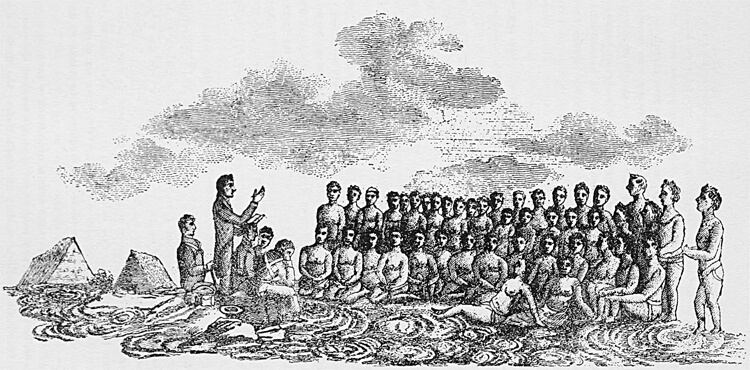
Missionaries and the Surfing Ban
As the great matriarch of the Hawaiian Islands, Kaahumanu controlled the kingdom on the death of Kamehameha.
She was also unwittingly to preside over the death of surfing for many years to come. At first, she ignored the newly arrived missionaries.
Later, impressed by their power to write (pala pala) and tell stories, she came under the influence of Hiram Bingham, one of the first and most unbending of their number.
Bingham, like all the early missionaries [in the sketch above], was against sports, dancing, feasting, music, nakedness, gambling, drinking, and adultery, all of which had been so close to the hearts of the ancient Hawaiians.
Due to his efforts and those of Kaahumanu, the remaining tabus were broken - only to be replaced by the far worse tabus of the Calvinists.
Surfing was against the hand of God, said the missionaries, although it was not to the surfing specifically that they objected, but to the associated sins, "the betting, the sexual freedom, and men and women surfing together in scanty costumes."
Time was being wasted, which could be better used for learning and hard manual work.
Eventually, Kaahumanu converted to the new religion and quickly ordered the destruction of the temples, including their wooden images, many of which were remarkable works of art.
So well was this accomplished that only one of these carved gods is in existence today.
Later historians specializing in the early missionary period are convinced that Kaahumanu became, to use the vernacular, the great and good friend of Mr. Bingham.
She built him a house next door to her own, and they were often seen together, the small New Englander with the burning black eyes and the magnificent 400-pound chiefess.
Somerset Maugham is reputed to have modeled the missionary in "Rain" on Mr. Bingham.
As Bingham's influence increased, gradually, all the games and sports that had delighted the Hawaiians and kept them fit and strong were forbidden.
The hula was banned, and so were chants.
Adulterers were banished to the desert islands of Lanai and Kahoolawe.
Those Hawaiians who had survived the arrival of the white man's diseases died in scores of broken hearts since everything they had once loved they were now told was wrong.
Such was their loyalty to their alii; there were few to question the word of the great Queen Kaahumanu.
Surfing, of course, was banned along with the rest of the games.
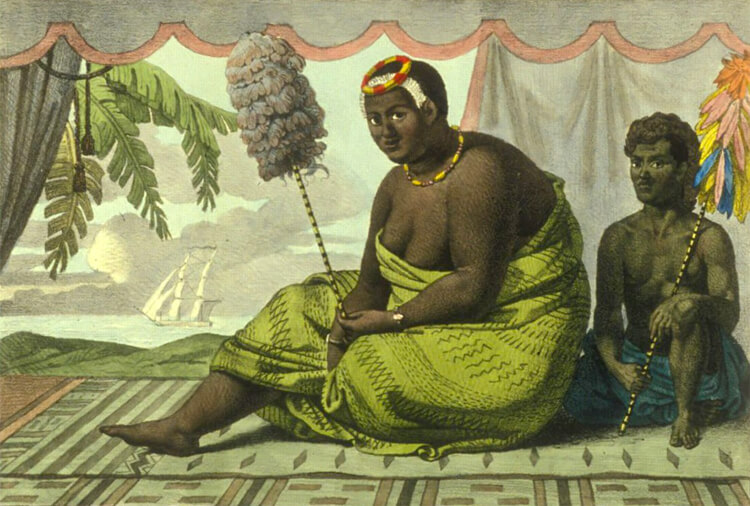
Restoring Hawaiian Culture
There was a brief revival at the beginning of the reign of the young King Kamehameha III, but apart from this, there was no extensive surfing activity in Hawaii until nearly 50 years later when David Kalakaua, the Merrie Monarch of the Pacific, restored the hula and the songs and the other beloved Hawaiian forms of cultural expression.
During this period, the surviving Hawaiians, many of whom had lost their lands to the missionaries, the sons of missionaries, and the sugar planters, were broken in spirit by the stern Calvinist requirements and in health by the hot clothes and the lack of sea and land sports.
They had been reduced from an estimated 400,000 at the time of Captain Cook to 50,000 in 1878.
For a brief period, Kalakaua succeeded in reversing these alarming bans.
Merry indeed, but also intelligent, warm-hearted, musical, and athletic, he was a king to delight the hearts of his life-loving subjects.
Sophia Cracroft and Lady Franklyn, the widow of the famous Arctic explorer, visited the Kona coast with Kalakaua just before he ascended the throne.
In her letters to her family in England, Miss Cracroft describes a surfing meet.
It is obvious from the text that Kalakaua had already started his campaign to revive Hawaiian sports and customs.
"At twelve, we started in our litters to a bay a little way below this, to see some surf riding... We were quite a cavalcade of horsemen and walkers - men, women, and children, some of whom accompanied us the whole way, some three miles - our bearers often running along merrily."
"We alighted at a very nice native house belonging to a chief of the lower grade, a very good looking man whom Mr. Kalakaua had introduced to us yesterday.
"He is an excellent surf rider and joined in the succeeding sports, which was also witnessed by a great number of people belonging to the village, who clustered all round the house."
"I fear that I can hardly give you a correct idea of surf-riding, but I will try."
"A man or woman swims out to the line of breakers, having before him a thin board from 4 to 6 feet long and about 15 inches wide; this in swimming he carries before him with one arm, swimming with the other.
"The curling waves are nothing to these swimmers - they either dive under them or ride up the face of the liquid wall and appear on the top of or behind it."
"They choose their wave according to its height and the direction it will take in reaching the shore, and then instead of facing it, they turn about, place the surfboard immediately in front, rise to the crest of the wave, and literally ride upon it with extended limbs until it has spent itself upon the beach."
"But if they perceive that it will cast itself against the rocks, then they turn around again and stop short."
"It is a really wonderful sight, and some are so expert that during their flying progress, they can spring upright on the surfboard and come in erect! We saw one man do this."
"All here living on the coast are as much at home in the water as on the land and seem to enjoy it thoroughly. The children begin from tender youth, three or four years old."
"You see them run into the edge of the water and out again - a little older and they go farther, and dance in the outer edge of the spent waves, throwing themselves down that the water might pass over them - older still and they have their tiny surfboards, being already good swimmers."
"Morning and noontime, you see them here by the dozen in the water, shouting, playing, jumping in from the rocks head foremost or straight upright, diving, standing on their heads, and dashing their legs in the air - in fact, their antics are innumerable."
During the actual reign of Kalakaua, Waikiki became very fashionable again, and frequent surfing parties were held there outside the King's beach house.
This was also the scene of numerous luaus and of the revival of the ancient hula.
Waikiki was once more the center of the cultural life of the Hawaiian court. Kalakaua's reign was merry to the end, but his reign was correspondingly short.
The halcyon days of the old Hawaii were on their way out, and when he died, surfing took another holiday.
A Short-Lived Decline Before the Boom
Queen Liliuokalani succeeded to the throne, but the sugar planters, from whose tax money the government was run, succeeded in ousting her and formed a republic.
With the break up of the monarchy and the subsequent turmoil during which time the islands were reluctantly annexed by America, surfing and other things Hawaiian again suffered a relapse to the point where, at the turn of the century, one writer mourned the fact that it was hard to find a surfboard outside a museum.
The decline this time was short-lived, for in the early 1900s, for the first time in recorded history, Caucasians began to surf at Waikiki.
There was a general revival of water sports all over the Islands, and from then on, surfing and surfers have never looked back.
Words by Desmond Muirhead | Golf Course Designer and Author of the Book "Surfing in Hawaii" (1962)
Chapter I of "Surfing in Hawaii" was published under the authorization of Rosemary J. Muirhead, one of the three daughters of Desmond Muirhead
